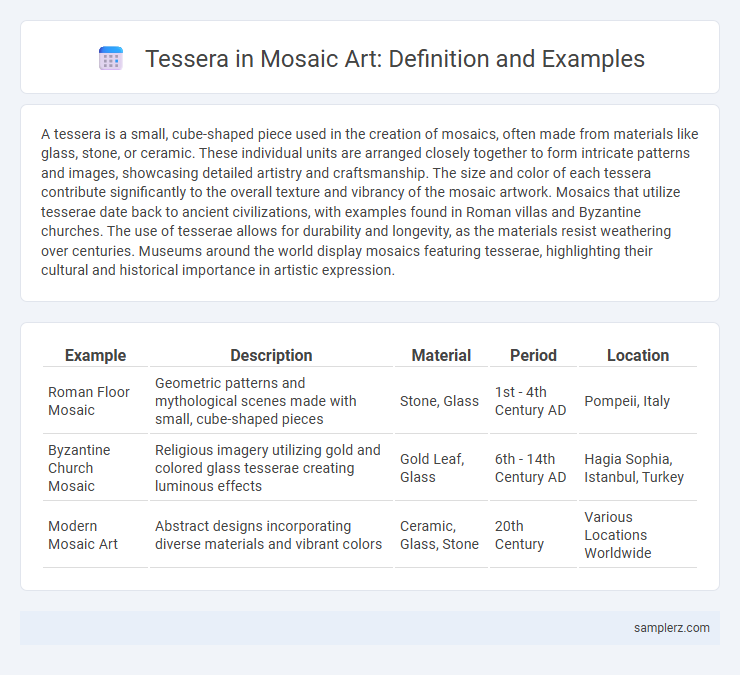A tessera is a small, cube-shaped piece used in the creation of mosaics, often made from materials like glass, stone, or ceramic. These individual units are arranged closely together to form intricate patterns and images, showcasing detailed artistry and craftsmanship. The size and color of each tessera contribute significantly to the overall texture and vibrancy of the mosaic artwork. Mosaics that utilize tesserae date back to ancient civilizations, with examples found in Roman villas and Byzantine churches. The use of tesserae allows for durability and longevity, as the materials resist weathering over centuries. Museums around the world display mosaics featuring tesserae, highlighting their cultural and historical importance in artistic expression.
Table of Comparison
| Example | Description | Material | Period | Location |
|---|---|---|---|---|
| Roman Floor Mosaic | Geometric patterns and mythological scenes made with small, cube-shaped pieces | Stone, Glass | 1st - 4th Century AD | Pompeii, Italy |
| Byzantine Church Mosaic | Religious imagery utilizing gold and colored glass tesserae creating luminous effects | Gold Leaf, Glass | 6th - 14th Century AD | Hagia Sophia, Istanbul, Turkey |
| Modern Mosaic Art | Abstract designs incorporating diverse materials and vibrant colors | Ceramic, Glass, Stone | 20th Century | Various Locations Worldwide |
Introduction to Tesserae in Mosaic Art
Tesserae are small, cube-shaped pieces of glass, stone, or ceramic used to create intricate mosaic artworks. These carefully arranged units contribute to detailed imagery and vibrant color patterns that define classical and contemporary mosaics. Understanding the variety and placement of tesserae is essential for appreciating the craftsmanship and texture in mosaic art.
Historical Overview of Tessera Usage
Tesserae, small blocks of stone, glass, or ceramic, have been used since ancient times to create intricate mosaic artworks, notably in Roman and Byzantine cultures. These pieces were carefully cut and arranged to form detailed images and patterns, with early examples dating back to the 3rd century BCE in Hellenistic Greece. The enduring use of tesserae highlights their significance in preserving cultural narratives and religious iconography throughout art history.
Materials Commonly Used for Tesserae
Tesserae in mosaics commonly use materials such as glass, stone, ceramic, and smalti, each chosen for durability and color vibrancy. Glass tesserae offer brilliant translucency and reflect light uniquely, often utilized in Byzantine mosaics for their vivid hues. Stone tesserae, including marble and limestone, provide natural texture and longevity, while ceramic pieces add versatility with glazed finishes for enhanced color variety.
Glass Tesserae: Vibrant Color and Shine
Glass tesserae in mosaics deliver vibrant color and luminous shine unmatched by other materials, enhancing visual depth and brilliance. Their translucent quality allows light to penetrate and reflect, creating dynamic shifts in hue and sparkle that animate the artwork. Richly pigmented glass pieces, often fused with metallic oxides, enable intricate color gradients and shimmering effects central to classical and contemporary mosaic art.
Stone Tesserae: Natural Texture and Durability
Stone tesserae in mosaic art offer a unique combination of natural texture and exceptional durability, making them ideal for both indoor and outdoor installations. Materials such as marble, granite, and limestone provide a diverse palette of colors and finishes, enhancing the visual depth and longevity of the artwork. Their resistance to weathering and wear ensures mosaics maintain their intricate detail and structural integrity over centuries.
Ceramic Tesserae: Handcrafted and Painted Examples
Ceramic tesserae, handcrafted and painted with intricate designs, serve as vital elements in ancient and contemporary mosaics, showcasing vivid colors and detailed textures. These ceramic pieces are meticulously shaped and glazed, allowing artists to create dynamic images with enhanced durability and visual depth. Notable examples include Byzantine mosaics and modern interpretations where ceramic tesserae bring both historical authenticity and artistic innovation.
Gold and Metallic Tesserae in Byzantine Mosaics
Gold and metallic tesserae in Byzantine mosaics exemplify the exquisite craftsmanship and symbolic richness of early Christian art. These tiny glass pieces, often backed with gold leaf, capture and reflect light to create a luminous, otherworldly effect that signifies divine presence. The strategic placement of gold tesserae in sacred spaces such as Hagia Sophia enhances the spiritual atmosphere, reinforcing the mosaics' roles as visual theology.
Recycled Materials as Modern Tesserae
Modern tesserae in mosaic art often incorporate recycled materials such as broken glass, ceramic shards, and repurposed plastic, enhancing sustainability while adding unique textures and colors. Artists use these recycled tesserae to create dynamic patterns that contribute to environmental awareness and innovative design techniques. This approach not only preserves resources but also introduces a contemporary aesthetic to the traditional mosaic medium.
Famous Mosaics and Their Specific Tessera Examples
The famous Byzantine mosaic in Hagia Sophia features tesserae made of gold leaf sandwiched between layers of glass, creating a shimmering effect that enhances religious imagery. Ravenna's Basilica of San Vitale showcases vibrant colored stone tesserae, such as jasper and porphyry, arranged to depict intricate biblical scenes. Venetian mosaics often used smalti tesserae, consisting of opaque glass fragments, prized for their intense hues and durability in works like St. Mark's Basilica.
Choosing Tesserae for Contemporary Mosaic Projects
Selecting tesserae for contemporary mosaic projects involves prioritizing materials such as glass, ceramic, and stone to achieve vibrant color contrasts and durable textures. Modern artists often combine traditional materials with innovative mediums like smalti and recycled elements to enhance depth and environmental sustainability. The careful choice of tessera size, shape, and finish directly influences the mosaic's overall aesthetic and tactile experience.

example of tessera in mosaic Infographic
 samplerz.com
samplerz.com